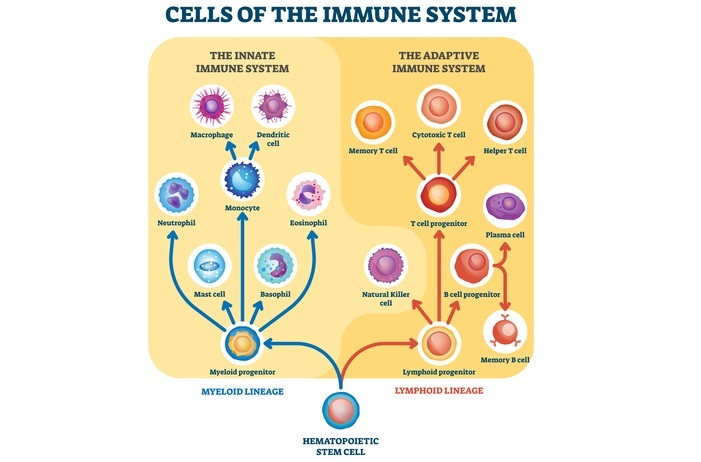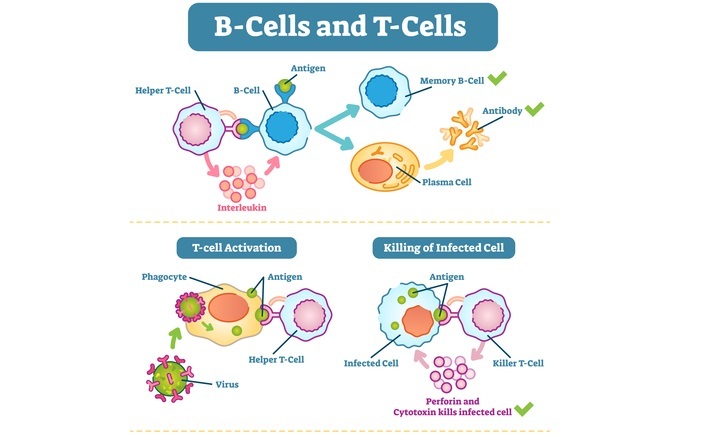
 Data Structure
Data Structure Networking
Networking RDBMS
RDBMS Operating System
Operating System Java
Java MS Excel
MS Excel iOS
iOS HTML
HTML CSS
CSS Android
Android Python
Python C Programming
C Programming C++
C++ C#
C# MongoDB
MongoDB MySQL
MySQL Javascript
Javascript PHP
PHP
- Selected Reading
- UPSC IAS Exams Notes
- Developer's Best Practices
- Questions and Answers
- Effective Resume Writing
- HR Interview Questions
- Computer Glossary
- Who is Who
V(D)J Recombination - A Defining Feature of the Adaptive Immune System
Introduction
The immune system is a complex network of cells, tissues, and organs that work together to defend the body against pathogens, such as bacteria, viruses, and fungi. The immune system can be divided into two categories ?
Innate Immune System
Adaptive Immune System.
The innate immune system provides the first line of defense against pathogens, while the adaptive immune system provides a specific response to pathogens.
The adaptive immune system is characterized by the ability to recognize and respond to specific pathogens and to retain a memory of past infections. The process that allows the adaptive immune system to recognize and respond to specific pathogens is called V(D)J recombination.

Let's discuss the process of V(D)J recombination, its importance in the adaptive immune system, and its applications in medicine.
V(D)J Recombination
V(D)J recombination is a process that occurs in the bone marrow of vertebrates during the development of B and T cells. B and T cells are the two types of lymphocytes that are responsible for the adaptive immune response.
It is the process that allows each B or T cell to produce a unique receptor that recognizes a specific antigen. The receptor on the surface of a B or T cell is called a B-cell receptor (BCR) or a T-cell receptor (TCR), respectively. The receptor is made up of two parts: a constant region and a variable region. The constant region is the same in all BCRs or TCRs of a given class (e.g., IgM or IgG for BCRs, or alpha-beta or gamma-delta for TCRs), while the variable region is unique to each BCR or TCR.

The variable region of the BCR or TCR is composed of two types of proteins: heavy chains and light chains for BCRs, and alpha and beta chains or gamma and delta chains for TCRs. The genes that encode the heavy and light chains for BCRs, and the alpha and beta chains or gamma and delta chains for TCRs, are arranged in a series of segments.
In humans, there are approximately 40 different segments for the heavy chain, 30 for the kappa light chain, 40 for the lambda light chain, 51 for the alpha chain, 52 for the beta chain, 14 for the gamma chain, and 2 for the delta chain. During V(D)J recombination, the segments that encode the variable region of the BCR or TCR are randomly selected and joined together to create a unique sequence.
The process of V(D)J recombination is mediated by the enzymes called RAG1 and RAG2. RAG1 and RAG2 recognize specific DNA sequences that flank the segments, called recombination signal sequences (RSS), and bring the segments together. The joining of the segments is accomplished by a series of nucleases and ligases that cut and rejoin the DNA.
The process of V(D)J recombination is a stochastic process, meaning that there is a certain amount of randomness in the selection of the segments and the joining of the DNA. This randomness is what allows the immune system to generate a diverse repertoire of BCRs and TCRs that can recognize a wide range of antigens.
Importance of V(D)J Recombination in the Adaptive Immune System
The process of V(D)J recombination is critical for the adaptive immune system to recognize and respond to specific pathogens. The ability to generate a diverse repertoire of BCRs and TCRs is what allows the immune system to recognize and respond to a wide range of antigens. Without V(D)J recombination, the adaptive immune system would be limited in its ability to respond to pathogens, and the body would be more susceptible to infection.
In addition to generating a diverse repertoire of BCRs and TCRs, V(D)J recombination also allows for the generation of memory B and T cells. Memory B and T cells are a subset of B and T cells that are produced during an initial immune response to a pathogen.
These cells retain a memory of the pathogen and can respond more quickly and effectively to subsequent infections by the same pathogen. The ability to generate memory B and T cells is a key feature of the adaptive immune system and is critical for long-term protection against infectious diseases.

Applications of V(D)J Recombination in Medicine
The process of V(D)J recombination has important applications in medicine, particularly in the field of immunology.
The ability to generate a diverse repertoire of BCRs and TCRs has led to the development of monoclonal antibody therapies and T-cell therapies for the treatment of cancer and other diseases.
Monoclonal antibodies are antibodies that are produced in the laboratory from a single B cell. The specificity of the antibody is determined by the variable region of the BCR, which is determined by V(D)J recombination.
Monoclonal antibodies can be designed to recognize and bind to specific antigens, such as tumor antigens, and can be used as targeted therapies for cancer.
T-cell therapies involve the isolation and manipulation of T cells from a patient's own immune system.
The T cells are engineered to recognize and attack cancer cells based on their expression of specific antigens. The specificity of the T-cell receptor is determined by V(D)J recombination.

